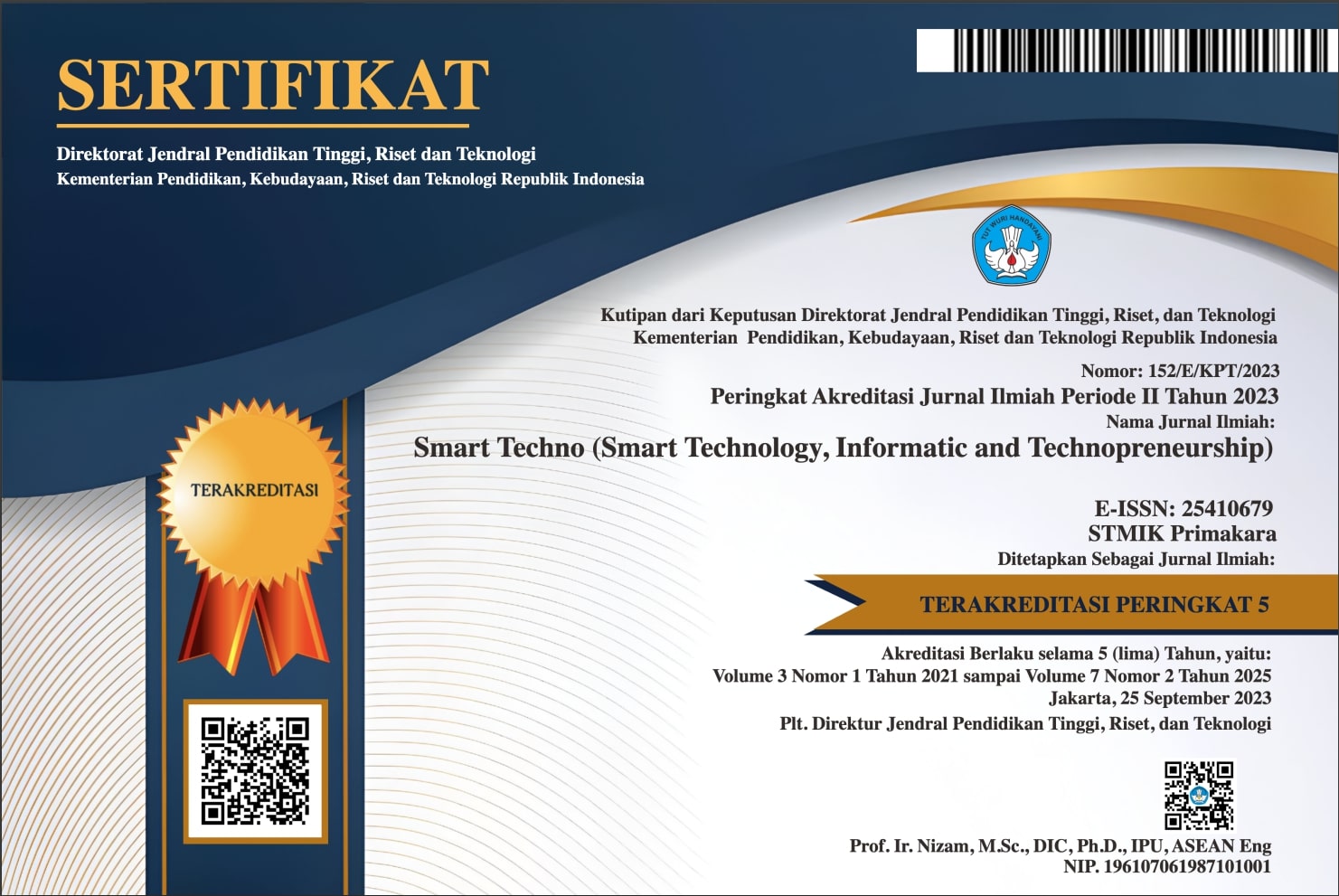Pengembangan Automatic Feeder Pakan Ikan Menggunakan Microcontroller ESP8266
Abstract
The Internet of Thing (IoT) is a combination of the internet and ubiquitoscomputing which has the function of controlling various kinds of electronic goods remotely and can be connected to various kinds of sensors. Technology can be used for the problem of feeding fish automatically which can be monitored from the blink application based on Android and IOS. The materials used in this study are iron and household furniture as construction, Mcu Esp8266 Node, Arduino, Loadcell, ultrasonic sensors, Servo Motors, and DC Motors. Tools that are made to work automatically run provide feed at predetermined hours and measure feed feed based on weight determined with a distance of ejection of feed up to 1 meter, and can be monitored using the blynk application via a local wifi network to find out the feed has been stocked and the amount of feed available in the main shelter.
Downloads
References
H. Anwari and E. S. Pramukantoro, “Pengembangan Iot Middleware Berbasis Event-Based dengan Protokol,” J. Pengemb. Teknol. Inf. dan Ilmu Komput., vol. 1, no. 12, pp. 1560–1567, 2017.
Arief Wahyu Wicaksono, Dahnial Syauqy dan Mochamad Hannats Hanafi Ichsan, “Sistem Embedded untuk Pengaturan Pakan lkan Mas Koki berdasarkan Banyaknya JumIah lkan dan Ketinggian Air”, Jurnal Pengembangan Teknologi Informasi dan Ilmu Komputer, 2019.
Kardiman,Dono martono,Rizal Hanifi, dan Eri Widiantod, “Pengembangan Sistem Kontrol Alat Penebar Pakan Ikan Otomatis Dengan Sumber Energi Matahari”, Journal Of Infrastructure and Science Engineering, 2019.
Heri Ngarianto dan Alexander, “Pengembangan Automatic Pet Feeder Mengunakan Platform Blynk Berbasis Mikrokontroler ESP8266”, Jurnal EMACS, 2020.
Y. Efendi, “Internet Of Things (Iot) Sistem Pengendalian Lampu Menggunakan Raspberry Pi Berbasis Mobile,” J. Ilm. Ilmu Komput., vol. 4, no. 1, pp. 19–26, 2018, doi: 10.35329/jiik.v4i1.48.
D. N. S. R. Suyanto, “Budi Daya Ikan Lele.” Penebar Swadaya, Jakarta, 2008, [Online]. Available: https://books.google.co.id/books?id=SEFjcIpP20wC&printsec=frontcover#v=onepage&q&f=false.
A. Harmanto, S. P. Tobing, A. Rahman, J. Rajawali, and P. S. Selatan, “Rancang Bangun Alat Pemberi Makan Ikan Otomatis Pada Akuarium menggunakan ESP 8266,” pp. 1–7.
A. Waluyo and N. Satyo, “Pemberi pakan ikan otomatis menggunakan esp8266 berbasis internet of things (iot),” 2018.
A. Bahsyar, R. H. S. T, M. I. S. T, F. I. Terapan, and U. Telkom, “Perancangan Dan Pembangunan Antar Muka Sistem Pemberi Pakan Ikan Otomatis Berbasis Web Designing and Developing a Web-Based Interface of Automatic Fish Feeding System,” vol. 3, no. 3, pp. 1895–1901, 2017.
Y. S. S. S. Yohanes Sergio Sili, “Rancang Bangun Alat Pemberian Pakan Ikan Koki Otomatis Pada Aquarium Berbasis Mikrokontroler AT89S52,” J. Fak. Teknol. Inf., no. Semester Genap2013/2014, 2014.
M. Muksin, “Simulasi alat pemberi pakan dan pengendali kincir air yang berdasarkan suhu dan kadar oksigen pada kolam ikan gurami berbasis mcu at89c51,” Widya Tek., vol. 18, no. 1, pp. 40–43, 2010.
Harifuzzumar, F. Arkan, and Ghiri Basuki Putra, “Perancangan Dan Impementasi Alat Pembe Rian Pakan Ikan Lele Otom Atis Pada Fase Pendederan Berbasis Arduino Dan Aplikasi Blynk,” Pros. Semin. Nas. Penelit. Pengabdi. pada Masy., pp. 67–71, 2018.
Y. A. Sari, Kartika, Cucu Suhery, “Implementasi Sistem Pakan Ikan Menggunakan Buzzer Dan Aplikasi Antarmuka Berbasis Mikrokontroler,” J. Coding Sist. Komput. Untan, vol. 3, no. 2, p. 113, 2015.
Copyright (c) 2020 Smart-Techno

This work is licensed under a Creative Commons Attribution 4.0 International License.
Authors who publish with the Smart Techno agree to the following terms:
- Authors retain copyright and grant the journal the right of first publication with the work simultaneously licensed under a Creative Commons Attribution License (CC BY-SA 4.0) that allows others to share the work with an acknowledgment of the work's authorship and initial publication in this journal.
- Authors are able to enter into separate, additional contractual arrangements for the non-exclusive distribution of the journal's published version of the work (e.g., post it to an institutional repository or publish it in a book), with an acknowledgment of its initial publication in this journal.
- Authors are permitted and encouraged to post their work online (e.g., in institutional repositories or on their website) prior to and during the submission process, as it can lead to productive exchanges, as well as earlier and greater citation of published work. (See The Effect of Open Access)







